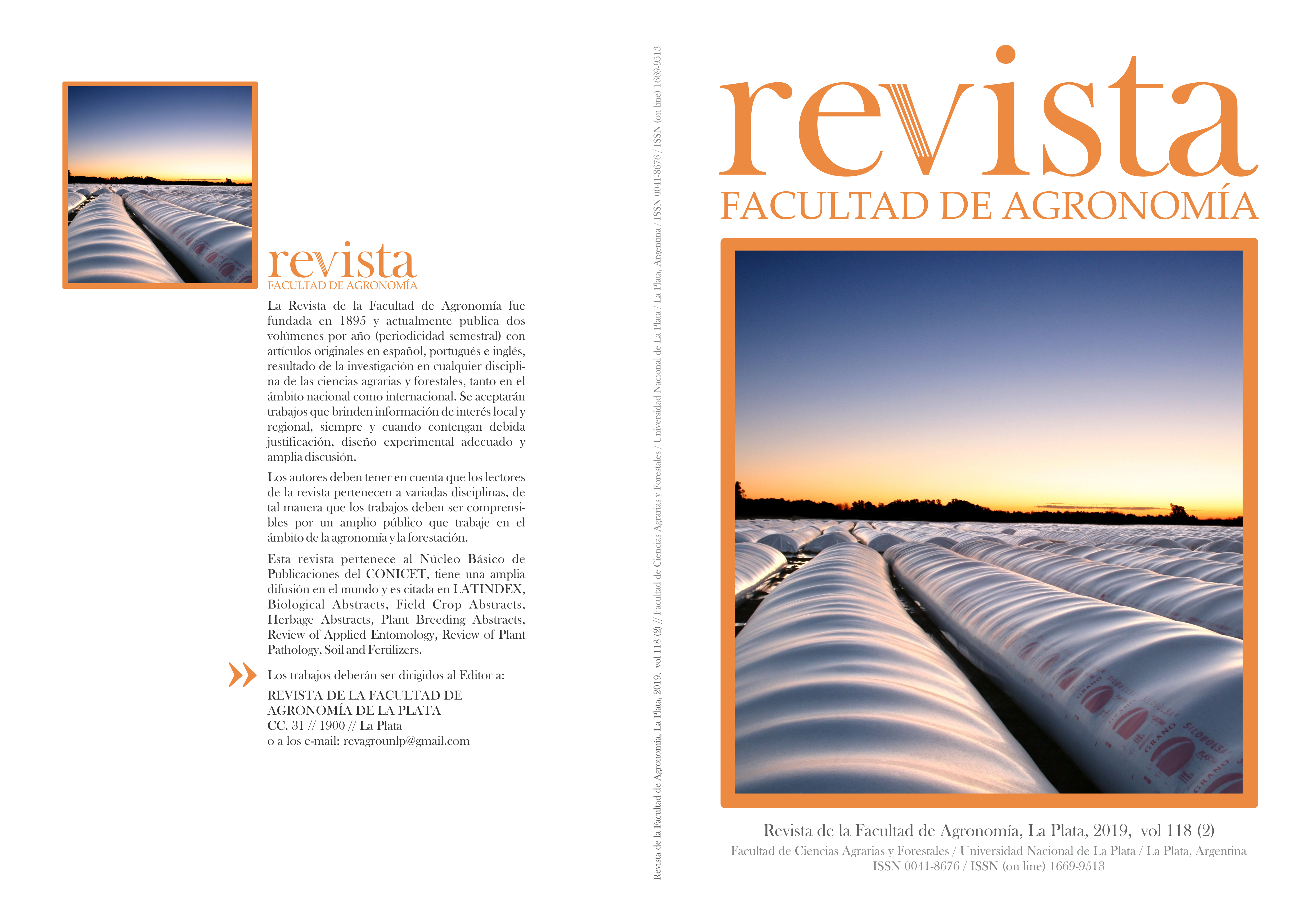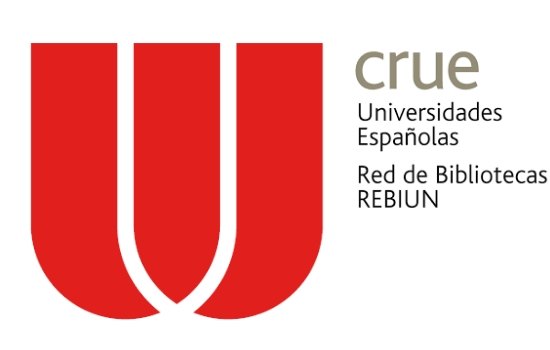Enterobacterias aisladas de suelos agrícolas de Argentina con efecto promotor del crecimiento de plantas y biocontrol sobre fitopatógenos
DOI:
https://doi.org/10.24215/16699513e022Palabras clave:
PGPB (Plant Growth Promoting Bacteria), solubilización de Pi, sideróforos, AIA, antagonistaResumen
Las bacterias que promueven el crecimiento vegetal lo hacen por diferentes mecanismos como la solubilización de fósforo, la síntesis de ácido indolacético y la producción de sideróforos. El objetivo de este trabajo fue aislar bacterias que promuevan el crecimiento de plantas y que también puedan actuar como organismos antagónicos de los hongos fitopatógenos. Los microorganismos fueron aislados de suelos de Tres Arroyos, pcia de Bs As y se encontraron bacterias solubilizadoras de fosfato inorgánico, que también sintetizan ácido indol acético y sideróforos. La capacidad de estas bacterias para solubilizar fosfatos (Pi) podría estar directamente relacionada con la síntesis de ácidos orgánicos que disminuyen el pH y no guardan relación con la actividad de la fosfatasa. La capacidad de los organismos para solubilizar Pi se relacionó indirectamente con la cantidad de Pi soluble presente en los medios. La capacidad de los microorganismos solubilizadores de Pi está principalmente asociada con el efecto de los exudados presentes en el rizoplano, sin embargo, esto no ocurrió en el caso de las bacterias evaluadas en el presente trabajo. Además de promover el crecimiento de las plantas, estas bacterias demostraron ser antagónicas de patógenos de plantas como Fusarium graminearum y F. solani.
Descargas
Referencias
Aadarsh, P., V. Deepa, P. Balakrishna Murthy, M. Deecaraman, R. Sridhar & P. Dhandapani. 2011. Insoluble phosphate solubilization by bacterial strains isolated from rice rhizosphere soils from Southern India. International Journal Soil Science 6(2): 134-141.
Ahemad, M. & M. Kibret. 2014. Mechanisms and applications of plant growth promoting rhizobacteria: Current perspective. Journal of King Saud University-Science 26(1): 1-20.
Ahmed, N. & S. Shahab. 2011. Phosphate solubilization: their mechanism genetics and application. Int. J. Microbiol, 9, 4408-4412.
Alexander, D.B. & D.A. Zuberer. 1991. Use of chrome azurol S reagent to evaluate siderophore production by rhizosphere bacteria. Biology and Fertility of Soils 12: 39-45.
Alvarez, R. 2017. Modeling soil test phosphorus changes under fertilized and unfertilized managements using artificial neural networks. Agronomy Journal, 109(5): 2278-2290.
Babalola, O.O. 2010. Beneficial bacteria of agricultural importance. Biotechnology letters 32(11): 1559-1570.
Badri D.V., T.L. Weir, D. van der Lelie & J.M. Vivanco. 2009. Rhizosphere chemical dialogues: plant–microbe interactions. Current opinion in biotechnology, 20(6): 642-650.
Bashan, Y., A.A. Kamnev & L.E. de-Bashan. 2013. Tricalcium phosphate is inappropriate as a universal selection factor for isolating and testing phosphate-solubilizing bacteria that enhance plant growth: a proposal for an alternative procedure. Biology and fertility of soils, 49(4): 465-479.
Bencini, D.A., Shanley, M.S., Wild J.R. & Donovan G.A. 1983. New assay for enzymatic phosphate release: application to aspartate transcarbamylase and other enzymes. Analytical Biochemistry 132: 259-264.
Beneduzi, A., Ambrosini, A. & Passaglia, L.M. 2012. Plant growth-promoting rhizobacteria (PGPR): their potential as antagonists and biocontrol agents. Genetics and molecular biology, 35(4): 1044-1051.
Bhattacharyya, P.N. & Jha, D.K. 2012. Plant growth-promoting rhizobacteria (PGPR): emergence in agriculture. World Journal of Microbiology and Biotechnology 28(4): 1327-1350.
Chen, P.S., Toribara, T.Y. & H. Warner. 1956. Microdetermination of Phosphorous. Analytical Chemical 28: 1756-1758.
de Bruijn, F.J. 1992. Use of repetitive (Repetitive Extragenic Palindromic and Enterobacterial Repetitive Intergenic Consensus) sequences and the polymerase chain reaction to fingerprint the genomes of Rhizobium melilotii isolates and other soil bacteria. Applied Environmental Microbiology 58: 2180-2187.
Effmert, U., J. Kalderás, R. Warnke & B. Piechulla. 2012. Volatile mediated interactions between bacteria and fungi in the soil. Journal of Chemical Ecology, 38(6): 665-703.
Ferreira, M.G. & M. Hungría. 2002. Recovery of soybean inoculants strains from uncropped soils in Brazil. Field Crops Research 79(2-3): 139-152.
Filippi, C., G. Bagnoli G. Treggi & G. Picci. 1984. Antagonistic effects of soil bacteria on Fusarium oxysporum Schlecht f. sp. dianthii (Prill and Del.) Snyd. and Hans. Plant and soil 80(1): 119-125.
Gamalero, E., G. Berta & B.R. Glick. 2009. The use of microorganisms to facilitate the growth of plants in saline soils. In Microbial strategies for crop improvement (pp. 1-22). Springer Berlin Heidelberg.
Gamo, M. & T. Shoji. 1999. A method of profiling microbial communities based on a most-probable-number assay that uses BIOLOG plates and multiple sole carbon sources. Applied and environmental microbiology 65(10): 4419-4424.
Ghosh, P., B. Rathinasabapathi & L.Q. Ma. 2015. Phosphorus solubilization and plant growth enhancement by arsenic-resistant bacteria. Chemosphere 134: 1-6.
Glick, B.R. 2012. Plant growth-promoting bacteria: mechanisms and applications. Scientifica, 2012.
Goldstein, A.H. & S.T. Liu. 1987. Molecular Cloning and regulation of a mineral phosphate solubilizing gene from Erwinia herbicola. Biotechnology 5: 72-74.
Gulati, A., Rahi, P. & P. Vyas. 2008. Characterization of phosphate-solubilizing fluorescent pseudomonads from the rhizosphere of seabuckthorn growing in the cold deserts of Himalay. Current Microbiology 56: 73–79.
Hameeda, B., G. Harini, O.P. Rupela, S.P. Wani & G. Reddy. 2008. Growth promotion of maize by phosphate-solubilizing bacteria isolated from composts and macrofauna. Microbiological research 163(2): 234-242.
He, Z.L. & X.E. Yang. 2007. Role of soil rhizobacteria in phytoremediation of heavy metal contaminated soils. Journal of Zhejiang University Science B 8(3): 192-207.
Husen, E. 2013. Screening of soil bacteria for plant growth promotion activities in vitro. Indonesian Journal of Agricultural Science, 4(1).
Illmer, P. & F. Schinner. 1992. Solubilization of inorganic phosphates by microorganisms isolated from forest soils. Soil Biology and Biochemistry 24: 389-395.
Katznelson, H., E.A. Peterson & J.W. Rouatt. 1962. Phosphate-dissolving microorganisms on seed and in the root zone of plants. Canadian Journal of Botany 40: 1041-1180.
Khan, M.S., A. Zaidi, P.A. Wani & M. Oves. 2009. Role of plant growth promoting rhizobacteria in the remediation of metal contaminated soils. Environmental Chemistry Letters 7(1): 1-19.
Kucey, R.M.N. 1983. Phosphate -solubilizing bacteria and fungi in various cultivated and virgin alberta soils. Canadian Journal of Soil Science 63: 671-678.
Kumar, A., C.S. Choudhary, D. Paswan, B. Kumar & A. Arun. 2014. Sustainable way for enhancing phosphorus efficiency in agricultural soils through phosphate solubilizing microbes. Journal of Soil science 9(2): 300-310.
Meinhardt, F., M. Busskamp & K.D. Wittchen. 1994. Cloning and sequencing of the leuC and nprM genes and a putative spoIV gene from Bacillus megaterium DSM319. Applied Microbiology and Biotechnology 41: 344–351.
Naik, P.R., G. Raman, K.B. Narayanan & N. Sakthivel. 2008. Assessment of genetic and functional diversity of phosphate solubilizing fluorescent pseudomonas isolated from rhizospheric soil. BMC microbiology, 8(1): 1.
Parra Gonzalez, E., S. Centeno Briceño & Y. Araque Calderon. 2009. Antifungal activity of Burkholderia cepacia isolated from yellow corn (Zea mays L.) under different culture conditions. Revista de la Sociedad Venezolana de Microbiología 29(2): 103-109.
Prasanna, A., V. Deepa, P.B. Murthy, M. Deecaraman, R. Sridhar & P. Dhandapani. 2011. Insoluble phosphate solubilization by bacterial strains isolated from rice rhizosphere soils from Southern India. International Journal of Soil Science, 6(2): 134.
Prévost, D. & H. Antoun. 2007. Root nodule bacteria and symbiotic nitrogen fixation. Soil sampling and methods of analysis, 2nd edn./Section IV—Soil Biological Analyses, 379-398.
Rajkumar, M., N. Ae, M.N.V. Prasad & H. Freitas. 2010. Potential of siderophore-producing bacteria for improving heavy metal phytoextraction. Trends in Biotechnology 28(3): 142-149.
Reed, M.L.E. & Glick, B.R. 2013. Applications of plant growth-promoting bacteria for plant and soil systems. Applications of Microbial Engineering. Taylor and Francis, Enfield, CT: 181-229.
Saldaña, G., V. Martínez-Alcántara, J.M. Vinardell, R. Bellogín, J.E. Ruíz-Sainz & P.A. Balatti. 2003. Genetic diversity of fast-growing rhizobia that nodulate soybean (Glycine max L. Merr). Archives of Microbiology 180: 45-52.
Sanger, F.S., S. Nicklen & A.R. Coulsen. 1977. DNA sequencing with chain-terminating inhibitors. Proceedings of the National Academy of Sciences USA 74: 5463–5467.
Scervino, J.M., V.L. Papinutti, M.S. Godoy, M.A. Rodriguez, I. Della Monica, M. Recchi, M.J. Pettinari & A.M. Godeas. 2011. Medium pH, carbon and nitrogen concentrations modulate the phosphate solubilization efficiency of Penicillium purpurogenum through organic acid production. Journal of Applied Microbiology 110(5): 1215-1223.
Shahid, M., S. Hameed, A. Imran, S. Ali & J.D. Van Elsas. 2012. Root colonization and growth promotion of sunflower (Helianthus annuus L.) by phosphate solubilizing Enterobacter sp. Fs-11. World Journal of Microbiology and Biotechnology 28(8): 2749-2758.
Sharma, S.B., R.Z. Sayyed, M.H. Trivedi & T.A. Gobi. 2013. Phosphate solubilizing microbes: sustainable approach for managing phosphorus deficiency in agricultural soils. SpringerPlus, 2(1): 1.
Son, J. S., Sumayo, M., Hwang, Y. J., Kim, B. S., & Ghim, S. Y. 2014. Screening of plant growth-promoting rhizobacteria as elicitor of systemic resistance against gray leaf spot disease in pepper. Applied soil ecology, 73: 1-8.
Sperber, J.I. 1958 Solution of apatite by soil microorganisms producing organic acids. Australian Journal of Agricultural Research 9: 782-787.
Tabatabai, M.A. & J.M. Bremner. 1969. Use of p-nitrophenyl phosphate for assay of soil phosphatase activity. Soil Biology and Biochemistry 1: 301–307.
Vazquez, P., G. Holguin, M.E. Puente, A. Lopez-Cortes & Y. Bashan. 2000. Phosphate-solubilizing microorganisms associated with the rhizosphere of mangroves in a semiarid coastal lagoon. Biology and Fertility of Soils, 30(5-6): 460-468.
Vassilev, N., M. Vassileva & I. Nikolaeva. 2006. Simultaneous P-solubilizing and biocontrol activity of microorganisms: potentials and future trends. Applied Microbiology and Biotechnology 71: 137-144.
Vinale, F., K. Sivasithamparam, E.L. Ghisalberti, R. Marra, S.L Woo & M. Lorito. 2008. Trichoderma–plant–pathogen interactions. Soil Biology and Biochemistry, 40(1): 1-10.
Wisniewski-Dyé, F., B. Drogue, S. Borland & C. Prigent-Combaret. 2013. Azospirillum-plant interaction: from root colonization to plant growth promotion. Beneficial plant-microbial interactions: ecology and applications: 237-269.
Descargas
Publicado
Número
Sección
Licencia
A partir de 2019 (Vol. 118 número 2) los artículos se publicarán en la revista bajo una licencia Creative Commons Atribución- NoComercial-CompartirIgual 4.0 Internacional (CC BY-NC-SA 4.0)
Acorde a estos términos, el material se puede compartir (copiar y redistribuir en cualquier medio o formato) y adaptar (remezclar, transformar y crear a partir del material otra obra), siempre que a) se cite la autoría y la fuente original de su publicación (revista y URL de la obra), b) no se use para fines comerciales y c) se mantengan los mismos términos de la licencia.
Previo a esta fecha los artículos se publicaron en la revista bajo una licencia Creative Commons Atribución (CC BY)
En ambos casos, la aceptación de los originales por parte de la revista implica la cesión no exclusiva de los derechos patrimoniales de los/as autores/as en favor del editor, quien permite la reutilización, luego de su edición (posprint), bajo la licencia que corresponda según la edición.
Tal cesión supone, por un lado, que luego de su edición (posprint) en Revista de la Facultad de Agronomía las/os autoras/es pueden publicar su trabajo en cualquier idioma, medio y formato (en tales casos, se solicita que se consigne que el material fue publicado originalmente en esta revista); por otro, la autorización de los/as autores/as para que el trabajo sea cosechado por SEDICI, el repositorio institucional de la Universidad Nacional de La Plata, y sea difundido en las bases de datos que el equipo editorial considere adecuadas para incrementar la visibilidad de la publicación y de sus autores/as.
Asimismo, la revista incentiva a las/os autoras/es para que luego de su publicación en Revista de la Facultad de Agronomía depositen sus producciones en otros repositorios institucionales y temáticos, bajo el principio de que ofrecer a la sociedad la producción científica y académica sin restricciones contribuye a un mayor intercambio del conocimiento global.


































